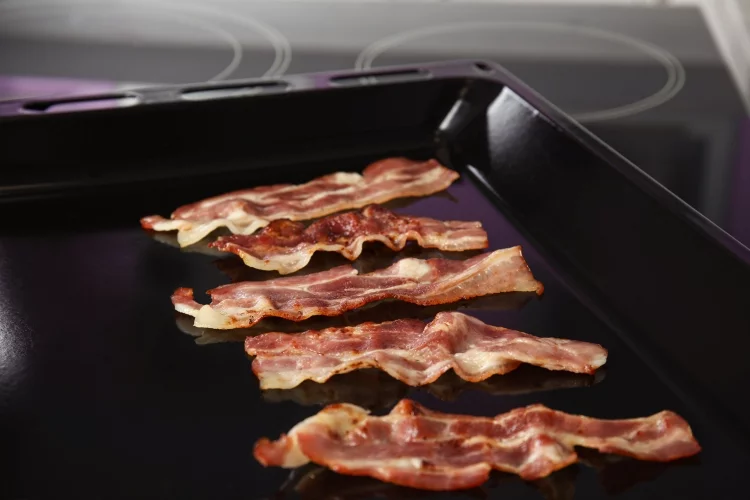by Rick Goldman
The satisfaction of frying perfectly cooked turkey bacon hits different, doesn't it? Crisp edges, the golden-brown strips, and that smokey tang make cheat day indulging all worth it. But, instead, do you find yourself in the constant rummage for the perfect guide on how to do it right?
Considering the vague instructions on the packaging, it might be difficult for you to estimate the right cook-time, amount of browning, and getting it crispy like the food commercials. To your relief, we have tried and tested many different ways on how to cook turkey bacon on stove just right, and here's the one we found the best.
Contents

Using the correct tools to fry your turkey bacon is crucial because you run the risk of overcooking and burning the food without them. Generally, we advise using a cast-iron skillet to fry the meat. It's the type of pan that is most commonly used to fry bacon and gives the best results.
If you don't have access to that, don't worry! A flat-bottomed griddle works just fine. The raised ridges will give you a flawless charred effect, perfect to enhance the smokey flavors in your meat. Moreover, it'll store the excess fat in the hollows of the pan, which helps in evenly greasing the strips of meat.
Alternatively, you could use a non-stick frypan to get your work done. This will be a perfect choice for you if you decide on avoiding extra fat to fry the meat strips in. Usually, bacon release their fat, which is more than enough for the meats to stop sticking on the pan and be moveable.
Additionally, you would need a pair of tongs to turn it around in the pan and to allow an even cook on both sides. If you don't have the option for that, you could use a fork or spoon. But be careful if you do so, as you might face oil splattering.
With turkey bacon, it's mostly a blend of light and dark turkey meat with a dash of appropriate seasonings. It all depends on the cut of the meat. Thicker cuts of bacon will give you a chewier result, and thinner cuts will provide you with crispier strips. Hence, the cuts depend on how you prefer your bacon.
Turkey bacon is also a great alternative to the usual one as it has a lesser amount of fat. But generally, look for strips that have greater meat to fat ratio and are nitrate-free. This will result in the most taste-worthy outcome.
This is the part for which most of you were waiting for, the method to actually cook the delicacy.
Step 1 : Start with the pan of your choice on the stove and your meat strips on it. Ensure your pan is cold and you haven't turned on the heat before placing the strips of meat on it.
Step 2 : Begin with crowding the pan a little, as the strips do shrink further upon frying. But do remember not to overcrowd them.
Step 3 : Cook them on low heat slowly. As we tested, bacon cooks the best at low flame. The strips start releasing fat soon; using your tongs, flip them on their other side and allow them to loosen up.
Step 4 : Keep repeating the last step until the strips turn brown and crispy evenly. At this point, you can pour off some of the excess greases filling up your pan if you think it's necessary. In any case, make sure to be careful as spilled oil can cause a grease fire.
Step 5 : Fry them until they're done. But when do you know they are done? This all comes down to how you like your bacon-whether you like it a little extra crunchy and fried or a little wobbly and saggy. Make sure to cook all its rawness away before taking it off the pan.
Step 6 : Prepare a plate with a paper towel on top to place the food out of the pan. Using your tongs, place the strips onto the paper towel to allow all of the excess grease to absorb and drain off.
Step 7 : If you have more strips to fry, then drain the excess grease and cook the remaining strips following the same steps again. If there is a layer of burned fat in your pan, wipe it away with a paper towel.
Even if you didn't end up using any extra oils to cook your bacon in, it's most likely that you are still going to have to drain some of the excess fat naturally released from it. As we mentioned earlier, placing a paper towel on top of your plate may help soak up most of the fat. Similarly, you can use a brown paper bag to do the same.
Even if you don't have any of the above at hand, you can also get the same done using a newspaper. In either case, make sure to place the paper on top of a plate to avoid most of the mess.
The extra grease that you get while cooking bacon, also commonly known as the drippings, is the reason for indecision of many. If you're health-conscious, dumping the drippings away would be the best.
But, the use of this liquid goodness is endless. Starting from flavor-boosting to using it as a gravy base, the possibilities of this precious substance is endless. If you want to save your drippings, too, simply pour it into a glass jar or a metal can.
But be careful of pouring your grease at excessively high temperatures, as it could result in the glass shattering. For maximum safety, let the liquid cool for a while before storing it.
Splatter touches can be extremely painful, mostly from fat-filled grease. Can you prevent it entirely? Not exactly, but you can minimize it using a splatter screen. Additionally, you can use a cooking apron and gloves to save your clothes and hands from painful splatters.
Having to clean up the mess usually created when cooking turkey bacon might be one big reason to intimidate many. But don't worry! We have been through that too, and we know just how you can finish it up in a matter of minutes.
After storing the drippings, if your pan has a layer of grease on it, place it on the stove and put some water in it and leave it to boil. While the water boils, use a spatula to carefully scrape off the residual grease or bacon bits from the pan. Allow the water to cool slightly before bringing it over to the sink and dumping the water.
If you're struggling with odor filling up your kitchen or your house while you cook bacon then, fear not! Dealing with it is pretty easy, simply turn on your kitchen exhaust or crack open one of the windows. Alternatively, you could opt to leave a bowl of vinegar out on your kitchen counter too.
Whether you want to cook this delicacy to add to your extensive menu list or trying it out yourself for the first time, it will undoubtedly leave you amazed with its delicious flavors. Plus, it isn't as complicated as it might seem, so stop pondering how to cook turkey bacons on the stove right and cook away!
 |
 |
 |
 |
 |
 |
 |
 |

About Rick Goldman
Rick Goldman's grandpa was a captain of a California coast cruise. This afforded Rick the luxury of traveling to exciting places along the Pacific Coast as a young boy. He got to try different, exotic foods on these journeys - something he really enjoys blogging about from his grandpa's beautiful garden home today.
Check for FREE Gifts. Or get our Free Cookbooks right now.
Disable the Ad Block to reveal all the recipes. Once done that, click on any button below
 |
 |
 |
 |